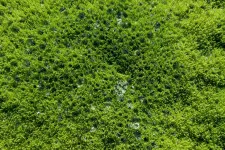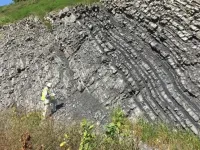INFORMATION:
The study received support from the European Research Council and NASA.
Arrival of land plants changed Earth's climate control system
The arrival of plants on land about 400 million years ago may have changed the way the Earth naturally regulates its own climate, according to a new study led by researchers at UCL (University College London) and Yale.
2021-07-15
(Press-News.org) The arrival of plants on land about 400 million years ago may have changed the way the Earth naturally regulates its own climate, according to a new study led by researchers at UCL and Yale.
The carbon cycle, the process through which carbon moves between rocks, oceans, living organisms and the atmosphere, acts as Earth's natural thermostat, regulating its temperature over long time periods.
In a new study, published in the journal Nature, researchers looked at samples from rocks spanning the last three billion years and found evidence of a dramatic change in how this cycle functioned about 400 million years ago, when plants started to colonise land.
Specifically, the researchers noted a change in the chemistry of seawater recorded in the rock that indicates a major shift in the global formation of clay - the "clay mineral factory" - from the oceans to the land.
Since clay forming in the ocean (reverse weathering) leads to carbon dioxide being released into the atmosphere, while clay on land is a byproduct of chemical weathering that removes carbon dioxide from the air, this reduced the amount of carbon in the atmosphere, leading to a cooler planet and a seesawing climate, with alternating ice ages and warmer periods.
The researchers suggested the switch was caused by the spread of land plants keeping soils and clays on land, stopping carbon from being washed into the ocean, and by the growth in marine life using silicon for their skeletons and cell walls, such as sponges, single-celled algae and radiolarians (a group of protozoa), leading to a drop in silicon in the seawater required for clay formation.
Senior author Dr Philip Pogge von Strandmann (UCL Earth Sciences) said: "Our study suggests that the carbon cycle operated in a fundamentally different way for most of Earth's history compared to the present day.
"The shift, which occurred gradually between 400 to 500 million years ago, appears to be linked to two major biological innovations at the time: the spread of plants on land and the growth of marine organisms that extract silicon from water to create their skeletons and cells walls.
"Before this change, atmospheric carbon dioxide remained high, leading to a stable, greenhouse climate. Since then, our climate has bounced back and forth between ice ages and warmer periods. This kind of change promotes evolution and during this period the evolution of complex life accelerated, with land-based animals forming for the first time.
"A less carbon-rich atmosphere is also more sensitive to change, allowing humans to influence the climate more easily through the burning of fossil fuels."
First author Boriana Kalderon-Asael, a PhD student at Yale University, said: "By measuring lithium isotopes in rocks spanning most of Earth's history, we aimed to investigate if anything had changed in the functioning of the carbon cycle over a large time scale. We found that it had, and this change appears to be linked to the growth of plant life on land and silicon-using animal life in the sea."
In the study, researchers measured lithium isotopes in 600 samples of rock taken from many different locations around the world. Lithium has two naturally occurring stable isotopes - one with three protons and three neutrons, and one with three protons and four neutrons.
When clay forms slowly on land, it strongly favours lithium-6, leaving surrounding water enriched with the other, heavier isotope, lithium-7. Analysing their samples using mass spectrometry, the researchers found a rise in the levels of lithium isotope-7 in seawater recorded in the rock occurring between 400 and 500 million years ago, suggesting a major shift in Earth's clay production coinciding with the spread of plants on land and emergence of silicon-using marine life.
Clay forms on land as a residue of chemical weathering, the primary long-term process through which carbon dioxide is removed from the atmosphere. This occurs when atmospheric carbon combines with water to form a weak acid, carbonic acid, which falls to the ground as rain and dissolves rocks, releasing ions including calcium ions that flow into the ocean. Eventually, the carbon is locked up in rocks on the ocean floor. In contrast, carbon drawdown by plant photosynthesis is negated once the plants decay, and rarely affects carbon dioxide levels on timescales longer than a few hundred years.
When clay forms in the ocean, carbon stays in the water and is eventually released into the air as part of the continual exchange of carbon that occurs when air meets water.
ELSE PRESS RELEASES FROM THIS DATE:
A new spidey sense
2021-07-15
Add this to the list of real-life spidey senses: Harvard researchers have shown that jumping spiders are able to tell the difference between animate objects and inanimate objects -- an ability previously known only in vertebrates, including humans.
Using a specialized treadmill system and a point-light display animation, the team of scientists found that these spiders are able to recognize biological motion. This type of motion refers to the visual movements that come from living organisms when they are moving. The visual cue is how people, even babies, can tell someone is another person just by the way their bodies move. Many animals can do this, too.
The ability, which is critical for survival, is evolutionarily ancient since it is so widespread ...
University of Minnesota develops new tool to help farmers make crop input decisions
2021-07-15
Reducing greenhouse gas emissions (GHGs) and nitrogen water pollution from agriculture are top environmental priorities in the United States. Key to achieving climate goals is helping producers navigate carbon markets, while also helping the environment and improving farm income.
A new tool developed by a University of Minnesota research team allows farmers to create a budget balance sheet of any nitrogen reduction plans and see the economic and environmental cost, return and margins, all customized to fields under their management.
"With these numbers in mind, farmers can make more informed decisions on ...
Wearable sensors with wide-ranging strain sensitivity
2021-07-15
(LOS ANGELES) - Many bodily functions in humans are manifested by mechanical deformations to the skin - from the stretching, bending and movement of muscles and joints to the flutter of a pulse at the wrist. These mechanical changes can be detected and monitored by measuring different levels of strain at various points throughout the body.
In recent years, much attention has been focused on wearable sensors to measure these strains for use in personal health monitoring. Some of these sensors can detect high-level (40-100%) strains, such as those associated with the movements of fingers ...
Protein-based vaccine candidate combined with potent adjuvant yields effective SARS-CoV-2 protection
2021-07-15
A new protein-based vaccine candidate combined with a potent adjuvant provided effective protection against SARS-CoV-2 when tested in animals, suggesting that the combination could add one more promising COVID-19 vaccine to the list of candidates for human use. The protein antigen, based on the receptor binding domain (RBD) of SARS-CoV-2, was expressed in yeast instead of mammalian cells - which the authors say could enable a scalable, temperature-stable, low-cost production process well suited for deployment in the developing world. In a study by Maria Pino and colleagues, the adjuvant ...
Study: Incarcerated people placed in solitary confinement differ significantly from others in prison population
2021-07-15
Concern has grown about prison systems' use of extended solitary confinement as a way to manage violent and disruptive incarcerated people. A new study identified groups that are more likely to be placed in extended solitary management (ESM). The study found that individuals sent to ESM differed considerably from the rest of the prison population in terms of mental health, education, language, race/ethnicity, and age.
The study, by researchers at Florida State University and the University of Cincinnati, appears in Justice Quarterly, a publication of the Academy of Criminal Justice Sciences.
"Many ...
Kelp for corn? Illinois scientists demystify natural products for crops
2021-07-15
URBANA, Ill. - Corn growers can choose from a wide array of products to make the most of their crop, but the latest could bring seaweed extract to a field near you. The marine product is just one class in a growing market of crop biostimulants marketed for corn.
Biostimulants benefit crops and soil, but the dizzying array of products has farmers confused, according to Fred Below, corn and soybean researcher at the University of Illinois.
"Farmers hear the term 'plant biostimulant' and think they all do the same thing, and can be used in the same way at the same time. But that's not the case. There's huge confusion ...
Climate regulation changed with the proliferation of marine animals and terrestrial plants
2021-07-15
Earth's climate was relatively stable for a long period of time. For three billion years, temperatures were mostly warm and carbon dioxide levels high - until a shift occurred about 400 million years ago. A new study suggests that the change at this time was accompanied by a fundamental alteration to the carbon-silicon cycle. "This transformation of what was a consistent status quo in the Precambrian era into the more unstable climate we see today was likely due to the emergence and spread of new life forms," said Professor Philip Pogge von Strandmann, a geoscientist at Johannes ...
When fawns perceive constant danger from many sources, they almost seem to relax
2021-07-15
Burnout. It is a syndrome that is said to afflict humans who feel chronic stress. But after conducting a novel study using trail cameras showing the interactions between white-tailed deer fawns and predators, a Penn State researcher suggests that prey animals feel it, too.
"And you can understand why they do," said Asia Murphy, who recently graduated with a doctorate from Penn State's Intercollege Graduate Degree Program in Ecology. "Less than half of whitetail fawns live to see their first birthday, and many are killed by predators, such as coyotes, black ...
Learning aids: Skoltech method helps train computer vision algorithms on limited data
2021-07-15
Researchers from Skoltech have found a way to help computer vision algorithms process satellite images of the Earth more accurately even with very limited data for training. This will make various remote sensing tasks easier for machines and ultimately the people who use their data. The paper outlining the new results was published in the journal Remote Sensing.
Researchers have been using computer vision and machine learning techniques to help with environmental monitoring for a while now. Tasks that may seem tedious and prone to human error are normally a piece of cake for algorithms. But before a neural network can successfully, say, discriminate between the kinds of trees in a forested area, it needs to be trained, ...
High daily screen time linked to cognitive, behavioral problems in children born extremely preterm
2021-07-15
WHAT:
Among 6- and 7-year-olds who were born extremely preterm--before the 28th week of pregnancy--those who had more than two hours of screen time a day were more likely to have deficits in overall IQ, executive functioning (problem solving skills), impulse control and attention, according to a study funded by the National Institutes of Health. Similarly, those who had a television or computer in their bedrooms were more likely to have problems with impulse control and paying attention. The findings suggest that high amounts of screen time may ...
LAST 30 PRESS RELEASES:
Evidence of cross-regional marine plastic pollution in green sea turtles
Patients with clonal hematopoiesis have increased heart disease risk following cancer treatment
Stem cell therapy for stroke shows how cells find their way in the brain
Environment: Up to 4,700 tonnes of litter flows down the Rhine each year
Maternal vaccine receipt and infant hospital and emergency visits for influenza and pertussis
Interim safety of RSVpreF vaccination during pregnancy
Stem cell engineering breakthrough paves way for next-generation living drugs
California grants $7.4 million to advance gene-edited stem cell therapy for Friedreich’s ataxia
Victoria’s Secret grant backs cutting-edge ovarian cancer research
Research paves the way for safer colonoscopy bowel prep for people with compromised gut health
JMIR Publications and Sweden's National Library announce renewal and expansion of flat-fee unlimited open access partnership for 2026
A new 3D-printed solar cell that’s transparent and color-tunable
IV iron is the cost-effective treatment for women with iron deficiency anemia and heavy menstrual bleeding
Doing good pays off: Environmentally and socially responsible companies drive value and market efficiency
City of Hope and Cellares to automate manufacturing of solid tumor CAR T cell therapy
Short-circuiting pancreatic cancer
Groundbreaking mapping: how many ghost particles all the Milky Way’s stars send towards Earth
JBNU researchers propose hierarchical porous copper nanosheet-based triboelectric nanogenerators
A high-protein diet can defeat cholera infection
A more accurate way of calculating the value of a healthy year of life
What causes some people’s gut microbes to produce high alcohol levels?
Global study reveals widespread burning of plastic for heating and cooking
MIT study shows pills that communicate from the stomach could improve medication adherence
Searching for the centromere: diversity in pathways key for cell division
Behind nature’s blueprints
Researchers search for why some people’s gut microbes produce high alcohol levels
Researchers find promising new way to boost the immune response to cancer
Coffee as a staining agent substitute in electron microscopy
Revealing the diversity of olfactory receptors in hagfish and its implications for early vertebrate evolution
Development of an ultrasonic sensor capable of cuffless, non-invasive blood pressure measurement
[Press-News.org] Arrival of land plants changed Earth's climate control systemThe arrival of plants on land about 400 million years ago may have changed the way the Earth naturally regulates its own climate, according to a new study led by researchers at UCL (University College London) and Yale.



